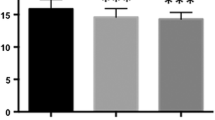Abstract
Purpose
The aim of this study is to establish standard MRI values for the cervical spinal canal, dural tube, and spinal cord, to evaluate age-related changes in healthy subjects, and to assess the prevalence of abnormal findings in asymptomatic subjects.
Methods
The sagittal diameter of the spinal canal and the sagittal diameter and cross-sectional area of the dural tube and spinal cord were measured on MRIs of 1,211 healthy volunteers. These included at least 100 men and 100 women in each decade of life between the third (20s) and eighth (70s). Abnormal findings such as spinal cord compression and signal changes in the spinal cord were recorded.
Results
The sagittal diameter of the spinal canal was 11.2 ± 1.4 mm [mean ± standard deviation (SD)]/11.1 ± 1.4 mm (male/female) at the mid-C5 vertebral level, and 9.5 ± 1.8/9.6 ± 1.6 mm at the C5/6 disc level. The cross-sectional area of the spinal cord was 78.1 ± 9.4/74.4 ± 9.4 mm2 at the mid-C5 level and 70.6 ± 11.7/68.9 ± 11.3 mm2 at the C5/6 disc level. Both the sagittal diameter and the axial area of the dural tube and spinal cord tended to decrease with increasing age. This tendency was more marked at the level of the intervertebral discs than at the level of the vertebral bodies, especially at the C5/6 intervertebral disc level. The spinal cord occupation rate in the dural tube at the C5 vertebral body level averaged 58.3 ± 7.0%. Spinal cord compression was observed in 64 cases (5.3%) and a T2 high-signal change was observed in 28 cases (2.3%).
Conclusions
Using MRI data of 1,211 asymptomatic subjects, the standard values for the cervical spinal canal, dural tube, and spinal cord for healthy members of each sex and each decade of life and the age-related changes in these parameters were established. The relatively high prevalence of abnormal MRI findings of the cervical spine in asymptomatic individuals emphasizes the dangers of predicating operative decisions on diagnostic tests without precisely correlating these findings with clinical signs and symptoms.






Similar content being viewed by others
References
Higo M, Sako T, Suzuki Y et al (1984) Roentgenological study of the antero-posterior diameter in cervical developmental canal stenosis. Rinsho Seikei Geka 19(4):361–366 (in Japanese)
Ishikawa M, Matsumoto M, Fujimura Y et al (2003) Changes of cervical spinal cord and cervical spinal canal with age in asymptomatic subjects. Spinal Cord. 41(3):159–163
Kameyama T, Hashizume Y, Ando T et al (1994) Morphometry of the normal cadaveric cervical spinal cord. Spine 19(18):2077–2081
Kimura I, Shingu H, Nasu Y et al (1983) Computed tomography of the spinal canal for the cervical spine and spinal cord injury. Rinsho Seikei Geka 18(5):541–551 (in Japanese)
Machino M, Yukawa Y, Ito K et al (2011) Can magnetic resonance imaging reflect the prognosis in patients of cervical spinal cord injury without radiographic abnormality? Spine 36(24):E1568–E1572
Okada E, Matsumoto M, Ichihara D et al (2009) Does the sagittal alignment of the cervical spine have an impact on disk degeneration? Minimum 10-year follow-up of asymptomatic volunteers. Eur Spine J 18(11):1644–1651
Okada E, Matsumoto M, Fujiwara H et al (2011) Disc degeneration of cervical spine on MRI in patients with lumbar disc herniation: comparison study with asymptomatic volunteers. Eur Spine J 20(4):585–591
Sasaki T, Kadoya S, Iizuka H (1998) Roentgenological study of the sagittal diameter of the cervical spinal canal in normal adult Japanese. Neurol Med Chir (Tokyo) 38(2):8–83 (discussion 88–89)
Shingu H, Ikata T, Katoh S et al (1994) Spinal cord injuries in Japan: a nationwide epidemiological survey in 1990. Paraplegia 32(1):3–8
Thijssen HO, Keyser A, Horstink MW et al (1979) Morphology of the cervical spinal cord on computed myelography. Neuroradiology 18(2):57–62
Yukawa Y, Kato F, Yoshihara H et al (2007) MR T2 image classification in cervical compression myelopathy. Predictor of surgical outcomes. Spine 32(15):1675–1678
Acknowledgments
This study was supported by institutional funds and by grant research funds, which are intended for promoting hospital functions, of the Japan Labor Health and Welfare Organization (Kawasaki, Japan). No benefits in any form have been or will be received from a commercial party related directly or indirectly to the subject of this manuscript.
Conflict of interest
None.
Author information
Authors and Affiliations
Corresponding author
Rights and permissions
About this article
Cite this article
Kato, F., Yukawa, Y., Suda, K. et al. Normal morphology, age-related changes and abnormal findings of the cervical spine. Part II: magnetic resonance imaging of over 1,200 asymptomatic subjects. Eur Spine J 21, 1499–1507 (2012). https://doi.org/10.1007/s00586-012-2176-4
Received:
Revised:
Accepted:
Published:
Issue Date:
DOI: https://doi.org/10.1007/s00586-012-2176-4




